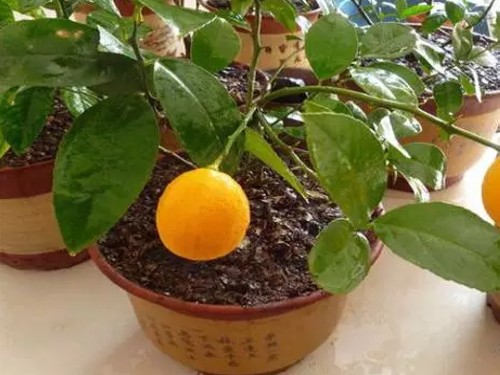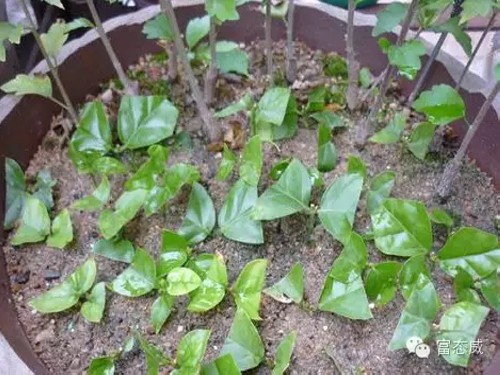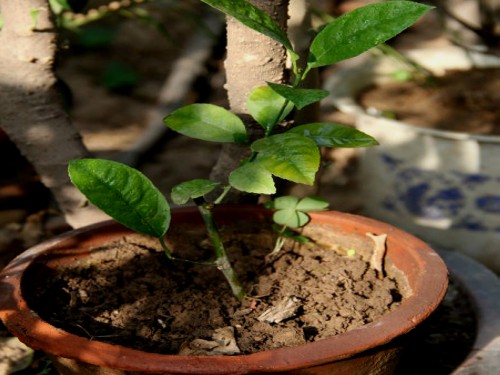Lemon pot cultivation method-propagation method of potted lemon tree
Lemon cultivation in the south, suitable for grafting propagation; North cultivation less, mainly with cuttage methods, but also can buy grafting seedlings cultivation. The root system of lemon has higher requirements for water, nutrients and soil. The potting soil should be prepared into permeable, breathable, water and fertilizer retaining, slightly acidic culture soil. On the basin and change basin time, autumn, early spring can be, according to the local climate flexible control.
Many flower friends have a kind of lemon tree heart, hope to reproduce a lemon tree, then we will talk about the reproduction of lemon trees. There are two methods of lemon propagation: cuttage and grafting, in which lemon grafting is commonly used to propagate.
1. Cutting propagation
The common propagation method of lemon is cuttage propagation. When cutting, it is advisable to choose about one year old (or close to one year old, too tender, easy to rot) branches, cut off most of the leaves, leaving only two (or two and a half leaves, used for photosynthesis, too much is not good, too much water consumption points), Cut obliquely about 1 cm below the lowest section and insert it into the seedbed. Note: The branch length is about 15 cm, that is to say, choose 3 or 4 nodes.

Mature branches are cut in late May. Each cutting is about 6 cm long. Two leaves are cut off 4/5. The cuttings are cut in clean river sand and inserted into 2/5 of the sand. The cuttings can be used in shallow pots or wooden boxes. The density is to the extent that the leaves of the cuttings do not touch each other. After cutting, water should be poured, placed in a semi-shaded place, covered with plastic film to maintain a high humidity, but the moisture should not be too much, too much will cause cutting rot. The optimum temperature for rooting is about 25℃. In the absence of any growth stimulants, generally 60-70 natural roots, rooting rate as high as 80%-90%, to grow new roots to 3-4 cm, can be transplanted seedlings; best transplanted to a nutrient bowl with humus, seedlings 20 cm high, can be planted.
II. Grafting propagation
Lemon is often propagated by grafting. The rootstock of lemon is often used abroad. Lime, coarse lemon and orange are often used abroad. Recently, it has been proved that orange is very good. Domestic selection of bitter orange as rootstock, but also available orange, orange, lemon (soil lemon), tangerine, select excellent individual scion, grafting method: spring with single bud cutting method, autumn with small bud abdominal grafting method.
1. Soil preparation
It is advisable to select plots with loose soil, fertile and good drainage to build gardens. In autumn and winter, according to the plant spacing of 3 meters ×4 meters, about 56 plants per mu can be planted. In hilly areas, circular holes with a depth of 0.8 meters and a width of 0.8 meters can be dug; in lowlands, planting can be shallow. 50kg soil manure and compost, 0.5kg lime, mixed with 0.5kg calcium superphosphate, mixed with topsoil and applied into the pit. 5~ 10kg fully decomposed pig and cattle manure was placed on the top layer. When filling back into the pit, it should be 20~ 30m above the ground surface and made into a tree tray of 0.8m.
2. Planting
In areas where rainfall is evenly distributed, or in gardens with good irrigation conditions, it can be planted all year round. Generally, lemon planting period is divided into spring planting (February ~ March) and autumn planting (September ~ October). It is planted on cloudy days. It is covered with enough root water to keep the grass moist. Later, it is often watered according to weather conditions to keep the soil moist.
III. Reproductive conditions
Best breeding time: breeding can be carried out throughout the year, of which the best breeding time in spring and autumn.
The best growing soil: lemon growth on the soil requirements are not strict, but with deep soil layer, loose, rich in organic matter, moisture and fertility, good drainage, low groundwater level, pH 5.5~6.5 slightly acidic soil is the best.
Growth humidity requirements: soil moisture slightly dry can be maintained.
The best growth temperature: lemon best growth temperature is 23℃~29℃, more than 35℃ stop growth,-2℃ that is subject to freezing damage.
The best growth light: lemon is a light-loving plant, but the sun is too strong, the growth and development is poor, summer high temperature should be appropriate shade.
Time: 2019-06-10 Click:
- Prev

Propagation methods of potted Chrysanthemum
Chrysanthemum is a plant of the family Compositae, which is used in medicine with head inflorescence. It has the effect of soothing wind and heat, clearing liver and eyesight, and is mainly used to treat exogenous wind-heat, dizziness and headache. Often drinking chrysanthemum tea has the function of avoiding summer heat and relieving annoyance. Chrysanthemums are cultivated all over the country, among which the famous one is the chrysanthemum from Anhui.
- Next

Can lemon trees be cut?-Lemon cutting technique
Citrus fruit seeds can be used to make fresh indoor potted plants, such as lemons, oranges and grapefruit. Of course, you must know some basic planting skills. It usually takes several years to grow fruit, so it takes a lot of patience. The appreciation of lemon potted plants is still very good.
Related
- Fuxing push coffee new agricultural production and marketing class: lack of small-scale processing plants
- Jujube rice field leisure farm deep ploughing Yilan for five years to create a space for organic food and play
- Nongyu Farm-A trial of organic papaya for brave women with advanced technology
- Four points for attention in the prevention and control of diseases and insect pests of edible fungi
- How to add nutrient solution to Edible Fungi
- Is there any good way to control edible fungus mites?
- Open Inoculation Technology of Edible Fungi
- Is there any clever way to use fertilizer for edible fungus in winter?
- What agents are used to kill the pathogens of edible fungi in the mushroom shed?
- Rapid drying of Edible Fungi

